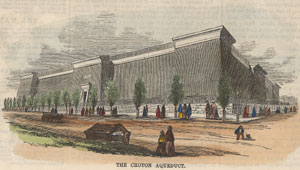 The Croton Reservoir: Wikimedia CommonsThe New York Times had a neat article yesterday about the history of the New York Public Library building, which stands on what once was the Croton Reservoir.
The Croton Reservoir: Wikimedia CommonsThe New York Times had a neat article yesterday about the history of the New York Public Library building, which stands on what once was the Croton Reservoir.
The reservoir opened for business in 1842 as the city's first central water system. The article sets the scene of the reservoir's opening day delightfully:
On opening day, July 4, 1842, more than 20,000 people visited the 250,000-gallon reservoir, each receiving a glass of Croton water, with ice. At a City Hall picnic Gov. William H. Seward announced that although yesterday New York had been “a dusty trading mart, unattractive and unadorned, today the pure mountain stream gushes through its streets and sparkles in its squares.” The reservoir was designed to provide 24 gallons a day for every one of the 600,000 people living in the city.
Only a few decades later, piped-in water was commonplace enough that calls for the reservoir's destruction became the norm:
The old magic of the reservoir was also lost upon The New York Times, which joined the call to pull the plug, calling it “useless,” and “a hideous object to the sight, and a blight upon the neighborhood,” its frequent leaks making the area damp and malarial. Two years later accounts appeared indicating that a new central library was to occupy the site, within the shell of City Hall, which was to be torn down and rebuilt there.
Now, the article concludes, the remains of the Croton Reservoir are forgotten by all but a few, even as the city's thirst has grown. It's clear, it concludes, that "the miracle of fresh water has long since been taken for granted:"
As The Times wrote in 1898, even the memory of the reservoir was destined “to be cast aside now that the limitless thirst of the population takes in the whole Croton Valley water supply.” And now, consuming 130 gallons per day per person, we have gone far beyond that.














